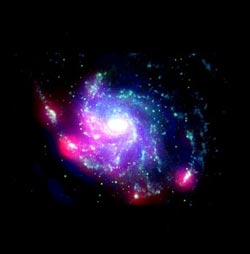Akari’s observations of galaxy M101

This is a composite image of the spiral galaxy M101. The image shows the distribution of cold (blue) and warm (red) dust overlaid on the visible (green, showing distribution of stars) and far-ultraviolet (cyan, indicating the location of young stars) images of M101. Credits: Composite: JAXA, visible (green): the National Geographic Society, far-ultraviolet (cyan): GALEX/NASA
Toyoaki Suzuki at the University of Tokyo conducted observations of M101 with AKARI at four infrared wavelengths (65, 90, 140, and 160 micrometres) using the Far-Infrared Surveyor (FIS) instrument.
Many young high-temperature stars populate the spiral arms, revealing the areas of star formation and warming the interstellar dust. This causes the galaxy to shine at shorter infrared wavelengths. In contrast, the longer wavelengths show where the ‘cold’ dust is located. Normal stars, typically like our own Sun, warm this dust.
FIS data was compared to an image of M101 in the visible and far-ultraviolet. It shows that warm dust is distributed along the spiral arms, with many hot spots located along the outer edge of the galaxy. These spots correspond to giant star-forming regions. This is unusual because star formation is generally more active in the central parts of spiral galaxies.
The evidence points to M101 having experienced a close encounter with a companion galaxy in the past, dragging out gas from the hapless companion. The gas is now falling onto the outer edge of M101 at approximately 150 km/s, triggering the active star formation.
Media Contact
More Information:
http://www.esa.int/esaSC/SEMYRSMPQ5F_index_0.htmlAll latest news from the category: Physics and Astronomy
This area deals with the fundamental laws and building blocks of nature and how they interact, the properties and the behavior of matter, and research into space and time and their structures.
innovations-report provides in-depth reports and articles on subjects such as astrophysics, laser technologies, nuclear, quantum, particle and solid-state physics, nanotechnologies, planetary research and findings (Mars, Venus) and developments related to the Hubble Telescope.
Newest articles

Trotting robots reveal emergence of animal gait transitions
A four-legged robot trained with machine learning by EPFL researchers has learned to avoid falls by spontaneously switching between walking, trotting, and pronking – a milestone for roboticists as well…

Innovation promises to prevent power pole-top fires
Engineers in Australia have found a new way to make power-pole insulators resistant to fire and electrical sparking, promising to prevent dangerous pole-top fires and reduce blackouts. Pole-top fires pose…

Possible alternative to antibiotics produced by bacteria
Antibacterial substance from staphylococci discovered with new mechanism of action against natural competitors. Many bacteria produce substances to gain an advantage over competitors in their highly competitive natural environment. Researchers…





















